When you are a therapist, you will naturally want to expand your name in the market. Simply creating a website will not do the work as other mental health professionals are taking the same approach. To stand out of the crowd and to cut through the intense competition, you need SEO for therapists.
You can make your website rank on the first page and get more client engagement with these SEO tactics. Soon, people will recognize your existence and will book appointments to get your professional help.
What is SEO for Therapists?
Search Engine Optimization (SEO) for therapists is the practice of optimizing a therapist’s business website and bolstering its online presence in order to secure higher ranks in SERPs. It makes their website is discoverable to potential clients looking for therapy sessions on Google’s search engines.
Google and other search engines aim to offer the most relevant and valuable results possible for every search. Employing SEO strategies for therapists on your website will bring you to the forefront of people’s searches for therapists.
SEO for therapists entails practices like crafting and posting high-end content by targeting therapy-associated keywords. It also involves other on-page, off-page, and technical SEO elements like site speed optimization, website structure management and monitoring overall user experience.
5 Benefits of Therapist SEO
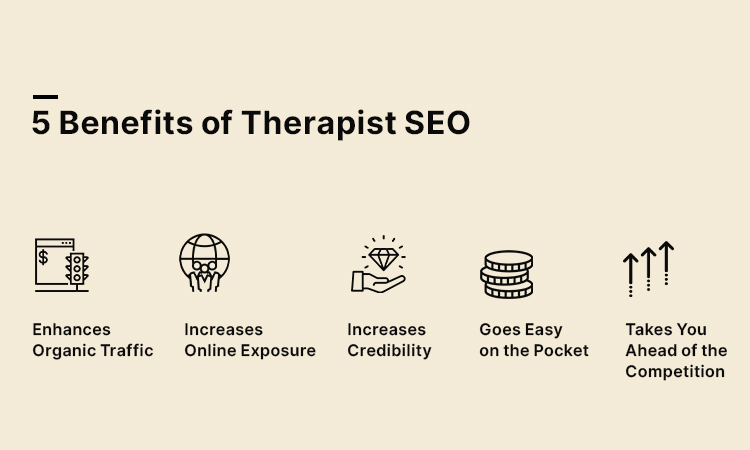
A therapist with a well-optimized website has several benefits associated with it. Let us walk you through the perks of having a solid SEO campaign designed for therapists.
- Enhances Organic Traffic
It is a fact that the most of people resort to Google search engines in order to look for “the best therapist near me.” Now, as a therapist with a business website, you will definitely want to enhance your organic traffic.
When you optimize your website with proper SEO tips, visitors will land on your website organically through organic search sources like Google. Search crawlers easily recognize the content of your website and present it on the screen of the visitors when it aligns with their search query.
An effective SEO strategy increases organic rank. Once this happens, your click-through rates experience a spike, and more people learn about your therapy services.
- Increases Online Exposure
A well-optimized SEO strategy allows you to share the limelight among the rest of the websites on the first page of the search engine results pages. Once you are on the top ten list, it automatically brings you closer to your target audience.
Your website will come to the radar of people who are looking for professional therapists. Therefore, employing solid SEO strategies to your website will help you with a better position on SERPs and more patients coming to your clinic.
- Increases Credibility
When Google finds your optimized website, consisting of relatable content with a robust backlink portfolio, it instantly increases your authenticity in their eyes. This helps your website rank higher on SERPs. It eventually helps you to earn more clicks and shares and gain more trust from the audience.
- Goes Easy on the Pocket
Search engine optimization is one of the most cost-effective digital marketing strategies. It is easy on the pockets when you are aiming for long-term results. With nominal investment, you can earn a handsome profit from your business. Therefore, it generates leads in the most budget-friendly manner.
- Takes You Ahead of the Competition
When you strategically implement SEO strategies for therapists, you are one step ahead of your competitors. With better ranking, more CTR, and conversion rates, you divert your audience towards yourself before they can reach your competitors.
SEO lets you analyze your industry trend, what keywords are impactful, and which strategy is giving your competitors an upper hand. When you get an idea of these things, it helps you to chalk out plans that will get you ahead of the competition.
10 Powerful Tried & Tested SEO Strategies for Therapists
Getting your website to rank on the first page of Google’s search engine results page is not a cakewalk. If you employ the SEO tips in your marketing campaign, you will surely land your desired goal smoothly.
We have listed below the ten best SEO strategies that will undoubtedly help you garner more organic footfall to your website, expose your therapy services to the world, and earn you better ROI.
- SWOT Analysis

Achieve the goal of a comprehensive evaluation of your website with a SWOT analysis. It is an acronym for Strengths, Weaknesses, Opportunities, and Threats. SWOT is one of the fundamental SEO strategies that helps therapists identify crucial aspects of their website.
SWOT delivers insights into the strengths of your website performance. You get a clear picture of which content is driving more traffic, the pages that are ranking well and more so. With this knowledge you can modify your strategies to work better on the weaknesses.
It informs you about the points where the website requires immediate attention and improvement. It highlights the aspects that can pose a threat and prove detrimental to the overall performance of the website.
In terms of opportunities, it keeps you updated with the scopes that are beneficial for the growth of the website. It helps to turn your strengths into opportunities.
SWOT analysis makes you completely aware of all the components that you must consider while optimizing your website. It gives you a clear insight into how you should plan out your SEO campaign for better results.
After learning what factors give you an upper hand among your competitors, and which ones are putting you at a disadvantage, you can adjust your plans accordingly.
Basically, SWOT analysis is similar to a roadmap that will guide you to the end of the tunnel. It gives you a detailed analysis of your website’s current standing among the relevant competitive sites. It answers your questions, “Where does my website stand?” and “Where is it going?”
SWOT Analysis Checklist
- Analyze your competitors to identify their SEO marketing strategies.
- Informs you about your website’s strong points and weaknesses.
- Explores opportunities where you can try your luck out.
- Perform Keyword Research to Reach Your Target Audience
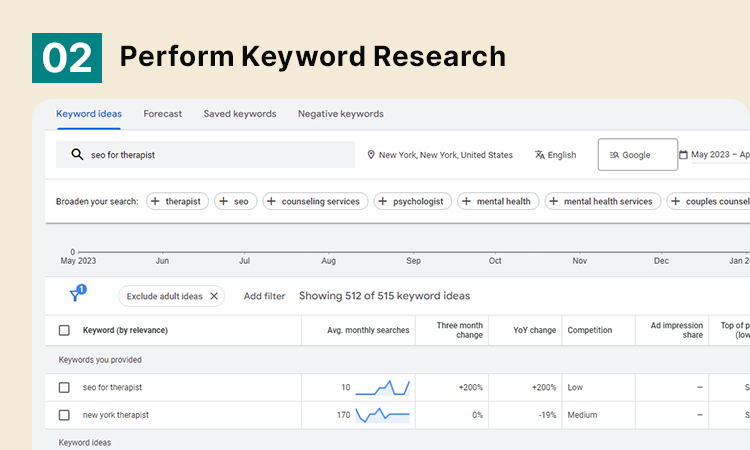
Keyword research is the process of identifying search terms and phrases that are popular and ranking well in your niche. It also involves understanding the search intent of the users. If you do not invest in gaining insights about what keywords are trending in the market or which ones to target, you are losing a major chunk of customers.
Therefore, it is absolutely necessary to identify keywords related to your niche business. Following this, you need to fish out those search terms with relatively lower keyword density despite having a higher volume.
For instance, target long-tail keywords like “therapy services for anxiety in New York” and ” SEO for therapists”. You can also aim for other related keywords like ” couple counseling services” and “social anxiety therapy services” and use them as secondary search terms in your content or whenever necessary.
You can optimize your content surrounding those keywords and you are good to go. This aids in outshining your competitors in terms of rank and organic traffic.
While we are on keyword research, you must also have a clear concept of the search intent. You must know what your target audience is looking for. Once you unlock this treasure, your keyword research process becomes smoother.
Keyword research checklist
- Invest in a keyword research tool
- Aim for long-tail keywords with comparatively lower keyword difficulty and high search volume
- Target keywords with high local search queries
- Top-Grade Content Creation Is Mandatory
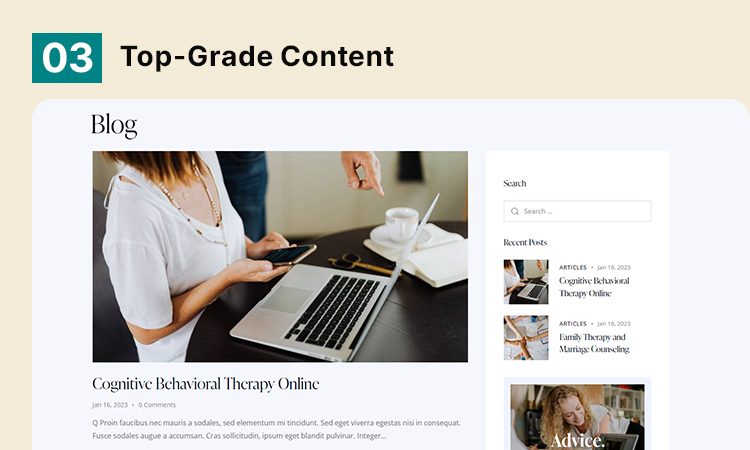
Creating content based on specific keywords is one of the main on-page SEO strategies. Unless and until the content is compelling enough to keep the readers, your website will suffer from heavy bounce rates.
Therefore, craft high-end, well-structured, crisp, and palatable website content for the readers. The more relevance they find in your content, it increases the chances of them converting into actual customers.
You can have a separate blog post section that highlights your counseling services, your contributions to mental health, and other business features.
If you regularly update your blog section with posts related to the targeted search terms from keyword research, you can come on Google’s radar. This acts as a catalyst for improved online visibility and increased organic traffic.
So, if anyone searches for “how to cope with depression”, if you have content related to this, Google will surely show your website on the first page of search results.
High-end content checklist
- Craft relatable and easy-to-comprehend content.
- Incorporate target keywords in your content naturally.
- Always try to use an active voice.
- Make sure to hyperlink your content with your website as well as other sites.
- Frequently upload blog posts on your website.
- Link Building to Establish Authority
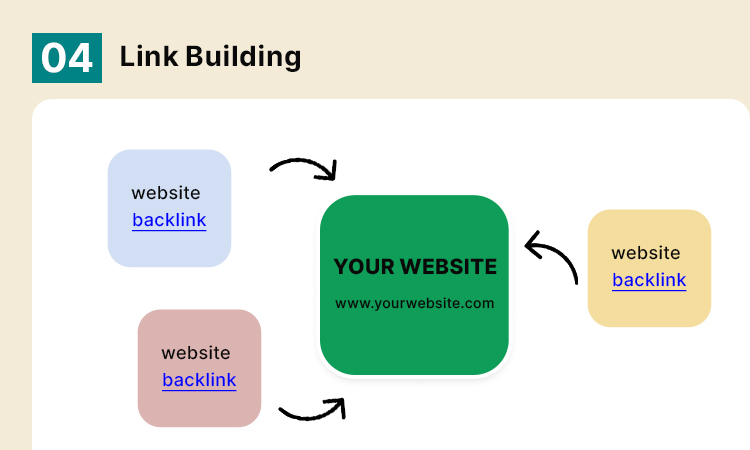
Link building and search engine optimization go hand in hand. Backlinks are links on other sites of your niche that point back to your website. The better the quality of the backlinks, the more is the trust gained from search engines.
These links are verdicts for Google’s bots. The more backlinks your website receives from relevant high-ranking websites, with greater domain authority, you gain the trust of Google and secure higher ranks.
Earning natural backlinks over time is the best white-hat SEO policy for building a robust backlink portfolio. You can start by proactively guest posting content on other relevant websites with higher domain authority and better popularity.
Furthermore, you can build linkable assets on your website by crafting content on niche-related popular search terms and phrases. Make those content targeted and purposeful. Leverage social media channels to create content that can reciprocate with the search intent of your potential customers. The more shares you receive, the more backlinks you earn to your website.
Link Building Checklist
- Avoid spammy links
- Naturally build links
- Start guest posting
- Try getting links from local directories
- Website Architecture for Better Navigation

Having a well-designed website architecture is an integral component to ensure a seamless user experience. A website with a logical hierarchy, where each web page is dedicated to every therapy session or mental health service you offer, leaves a good impression on visitors.
Simply ensure the person searching can access your web pages with just a few clicks. You can do so by creating an easy-to-follow navigation menu similar to the “contents page” of a book. The better the navigation, the higher the conversion rates.
If a website’s structure is on-point, it impacts your SEO efforts tremendously. It helps search engines discover and index your website pages easily.
Additionally, it distributes authority across your web pages via internal links. That’s how a responsive website structure is created. All you need to do is keep the internal linking your pages while optimizing website architecture.
A good website structure helps you rank higher on SERPs, as it helps Google to effortlessly comprehend your website’s content. The moment web crawlers encounter a disoriented therapy business website, your rank and potential client count immediately plummet.
Website architecture checklist
- Opt for a flat and clean website structure in place of a deep website structure
- Strategically flock similar content together with internal links
- Highlight important web pages to make them prominent to viewers.
- Avoid orphan pages
- Keep the URLs simple, precise, and short.
- Mobile-Friendliness of Website Matters the Most
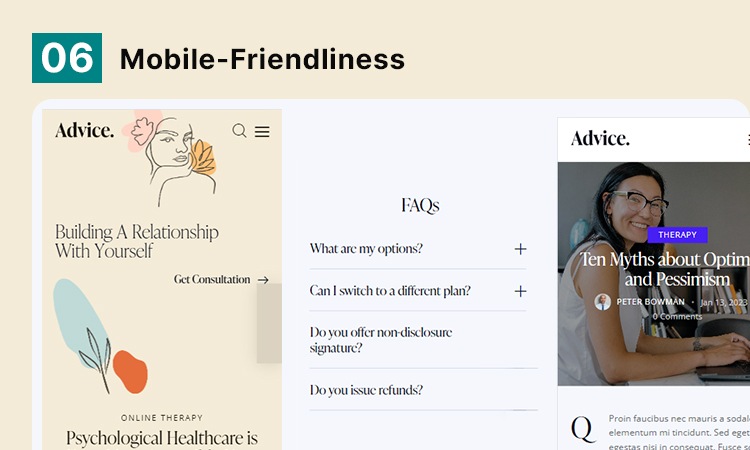
Figures don’t lie, and the truth is that 63% of searches occur on Mobile Devices in the United States. This consolidates the importance of having mobile-friendly therapist websites to cater to those clients looking for professional therapy help.
When a visitor clicks on your website URL from their phone and encounters loading issues, not only does this increase the bounce rate, but also drops your search engine rankings.
The question is, why will it affect ranking in Google search results?
Since 2016, Google has started using mobile-friendliness as an indexing and crawling factor to rank websites. Therefore, it is your Hobson’s choice because if your therapist website is not mobile-optimized, you will lose a major chunk of potential clients.
Therefore, ensuring your website loads perfectly in the end-user’s viewport is part of your successful SEO campaign. Make sure the user does not have to zoom in and zoom out continuously to read through your content. Otherwise, it will hamper the user experience.
Create a responsive website that adjusts to every phone screen, regardless of its resolution. This enables the website to adjust and readjust itself according to different screen sizes.
Not only content but also images need to be adjusted as well. It may be a bit difficult to make it compatible with every device screen but the CSS max-width property makes the process easier for you.
Mobile Optimization Checklist
- Use Fluid Grids
- Make sure to make your website compatible with various mobile devices.
- Add new media queries in the CSS
- Local SEO for Therapists
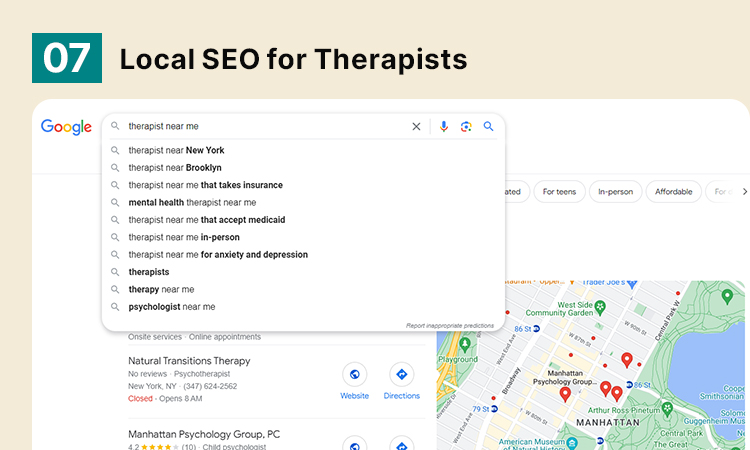
Local SEO for therapists is the practice of refining your online visibility to amplify your local traffic and brand awareness. It involves optimizing GBP, fishing out local keywords, and punctuating your website content with them.
Statistics show that 46% of Google searches consist of local searches. These people look for businesses within their vicinity. This implies that therapists or mental health professionals with a private practice clinic can immensely benefit from local SEO.
You can begin by optimizing your content with location-specific information to rank higher on organic local search results.
Following this, you can focus on optimizing your Google business profile (GBP). It is one of the most crucial parts of local SEO for therapists. To do this, you simply need to fill out your GBP form, which will include all essential information about your business.
The GBP profile should include your name, address, phone number, therapy session hours, and the link to your private practice website. You must also stay consistent with your NAP details across all platforms.
Moreover, incorporate location-specific relevant keywords in your meta description, title tag, or heading. It sends signals to Google search engines about the website category and the therapy services you offer.
Therefore, whenever anyone from the target geographical location searches with keywords like, “best therapist near me’’ your website will appear on their screen as one of the results on the first page of SERPs.
Local SEO checklist
- Mention accurate business details in your GBP.
- Always remain consistent with your NAP details
- Use popular local keywords in your content marketing strategy
- Voice Search Optimization & Save Time of The Users

Voice SEO is the process of optimizing popular and relevant keywords and phrases for searches using voice assistants. It involves enhancing your therapy business website to get chosen by search engines whenever there are voice search queries.
Statistics show that 27% of the world’s online population uses voice assistance like Siri, Alexa, and Google Assistant to search their queries on phones. Not only does it save effort, but it is also a faster process. This clearly indicates how important it is to make your website voice search optimized if you want better reach among your target audience.
Voice search optimization is not a tough nut to crack. It is the process of modifying your website in a way so that it will show up when voice assistants search for a query relevant to your business.
For instance, if anyone commands Alexa asks for “the best couple counseling therapist in San Diego ”, your website will appear if it is voice-optimized and geotargeted accurately.
It enables you to target long-tail keywords and keeps you ahead of your competitors. Hence, you should absolutely include voice-search optimization in your SEO strategy.
Neglecting this aspect might not put you in much of a backlog, but you might lose on potential clients who prefer voice typing to hand typing.
Voice Search Optimization Checklist
- Aim for long-tail keywords and conversational phrases
- Use multilingual voice search
- Focus on your site’s technical SEO and get it right.
- Optimize Core Web Vitals for Improved Website Performance
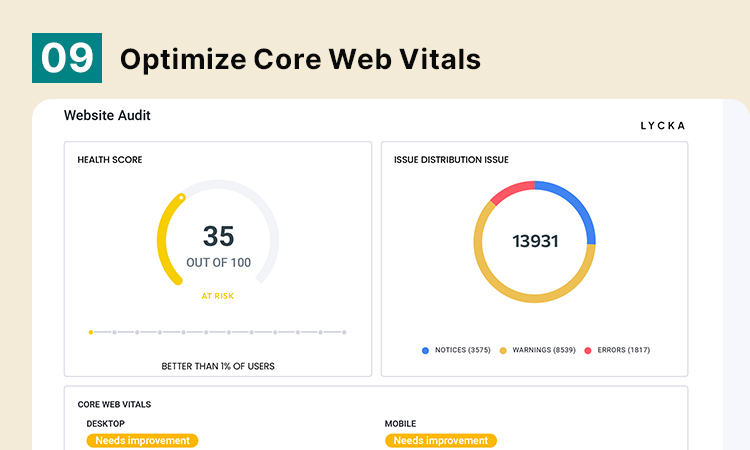
Core Web Vital uses its metrics to analyze your therapy business website in the aspect of its user-friendliness. It evaluates the website’s load time, visual stability, and user interactivity. It keeps your downtime at 0% and boosts the quality and user experience, thereby reducing the bounce rates.
The major metrics of core web vitals are:
- Largest Contentful Paint
- Cumulative Layout Shift
- Interactive to Next Paint
LCP measures how fast the image, video, graphic, or any large chunk of content loads as soon as the visitor clicks the URL. If your LCP is less than 2.5 seconds, your technical SEO is working just fine. If it is over 3 or 4 seconds, you need to work on it.
CLS gauges the shifts of the page elements while it is loading. A good CLS score ranges from 0.1 or fewer seconds. It makes it easier for users looking for therapy services to navigate through your therapy website.
INP, previously known as FID, calculates the time it takes for a page to load after a user’s action. Having an INP of 200 milliseconds is a healthy sign for your therapy website. However, if it is over 400-500 seconds, you might have to start working on it immediately.
To check your site’s core web vitals, you can use tools like Semrush Site Audit, Google page speed insights, and Google Search Console. As a therapist with the aim to rank your website higher on SERPs, start working on improving your core web vitals, if required.
Core Web Vitals Checklist
- Reduce your image sizes, CSS, and Javascript
- Use top-tier CDN service to improve site speed.
- Use a responsive website design.
- SEO Monitoring is a Necessity
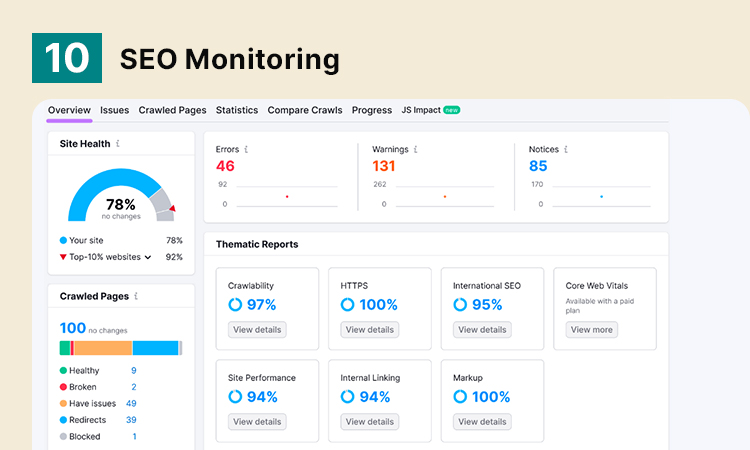
The reason most SEO campaigns fail is that they neglect the part where they have to monitor their performance. It surely is laborious and time-consuming, but there is light at the end of the tunnel. Eventually, it reaps good results.
Website monitoring offers you insights into your website performance. This helps you to formulate even better strategies to gain better results than before. You can see which keywords are ranking and what is your CTR, conversion rate, traffic source, traffic volume, etc.
SEO Monitoring Checklist
- Run frequent website audit
- Review your past content and update it as per the requirement.
- Keep track of website uptime
- Always keep up with the nuances of Google’s algorithm.
Wrapping Up
By now, you have an idea of what a solid SEO for therapist’s campaign entails. Though it might look a bit intimidating at first, however, with time, you can master the ropes easily.
If you are doing it on your own, take your sweet time to understand the intricacies of SEO, and then you can do wonders in optimizing your website. Some might find it difficult to manage their business and monitor their website simultaneously as active therapists. In that case, they can always seek the help of a professional SEO agency.


